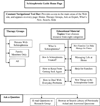A Clinical Trial to Test the Feasibility of a Telehealth Psychoeducational Intervention for Persons With Schizophrenia and Their Families: Intervention and 3-Month Findings
- PMID: 26321774
- PMCID: PMC4552359
- DOI: 10.1037/0090-5550.50.4.325
A Clinical Trial to Test the Feasibility of a Telehealth Psychoeducational Intervention for Persons With Schizophrenia and Their Families: Intervention and 3-Month Findings
Abstract
Objective: To evaluate the feasibility of a telehealth psychoeducation intervention for persons with schizophrenia and their family members.
Study design: Randomized controlled trial.
Participants: 30 persons with schizophrenia and 21 family members or other informal support persons.
Interventions: Web-based psychoeducation program that provided online group therapy and education.
Main outcome measures: Measures for persons with schizophrenia included perceived stress and perceived social support; for family members, they included disease-related distress and perceived social support.
Results: At 3 months, participants with schizophrenia in the intervention group reported lower perceived stress (p = .04) and showed a trend for a higher perceived level of social support (p = .06).
Conclusions: The findings demonstrate the feasibility and impact of providing telehealth-based psychosocial treatments, including online therapy groups, to persons with schizophrenia and their families.
Keywords: group therapy; online treatment; psychoeducation; schizophrenia; telehealth.
Figures






References
-
- American Psychiatric Association. Diagnostic and statistical manual of mental disorders. 4th ed. Washington, DC: Author; 1994.
-
- Anderson CV, Reiss DJ, Hogarty GE. Schizophrenia and the family: A practitioner’s guide to psychoeducation and management. New York: Guilford Press; 1986.
-
- Barrowclough C, Tarrier N. Families of schizophrenic patients, cognitive behavioural intervention. London: Chapman & Hall; 1992.
-
- Burns T. Psychosocial interventions. Current Opinion in Psychiatry. 1997;10:36–39.

